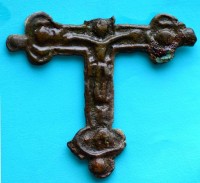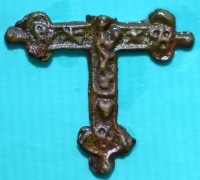 An archaeological team excavating the Newfoundland colony of Avalon, founded in 1620 by George Calvert, First Baron Baltimore, has discovered a small copper crucifix dating to the early days of the settlement. It’s just 2.8 centimeters (1.1 inches) wide at the arms and has the traditional image of Christ on the cross on the front. On the back is the Virgin Mary cradling the Christ child. The features of the relief are worn almost smooth, indicating that the devotional object was rubbed constantly. Coupled with its small size and broken top, it suggests the crucifix was once part of a rosary.
An archaeological team excavating the Newfoundland colony of Avalon, founded in 1620 by George Calvert, First Baron Baltimore, has discovered a small copper crucifix dating to the early days of the settlement. It’s just 2.8 centimeters (1.1 inches) wide at the arms and has the traditional image of Christ on the cross on the front. On the back is the Virgin Mary cradling the Christ child. The features of the relief are worn almost smooth, indicating that the devotional object was rubbed constantly. Coupled with its small size and broken top, it suggests the crucifix was once part of a rosary.
The crucifix was amongst a collection of ceramics, bones, nails and building debris associated with the construction of a large stone dwelling built for Sir George Calvert, the first Lord Baltimore, in Ferryland, Newfoundland. The dwelling was started sometime after 1623 and completed before the arrival of Calvert, most of his family and about 40 additional settlers in 1628. The cultural deposit containing the crucifix was sealed sometime in the second half of the 1620s, thus providing a securely datable context for the artifacts and a window into the lives of those who worked at Calvert’s colony of Avalon during this early period.
This is the first unambiguously Catholic object found from the time of Calvert’s founding of the colony, and as such it is of singular importance. George Calvert served as King James I’s Secretary of State for six years before resigning and officially converting to Catholicism in 1625. There’s some question as to whether that was the result of a revelation in the moment or the public confirmation of a long-held but hidden faith. His father Leonard was Catholic and in the fraught environment of the Elizabethan religious reforms, suffered constant harassment from the authorities for such crimes as employing Catholics and not going to Church of England services. Little George became a pawn in this game, being forced at age 12 to change tutors to an approved Protestant who would eschew the “popish primer” his previous tutor had employed.
 In order to graduate from Oxford and carve out a career for himself as a diplomat and politician at the court of King James, George Calvert certainly professed Protestantism. His wife was Protestant and he raised his children Protestant. By all accounts he was an honest, decent man so there’s no reason to assume he was being deceptive about his religious faith, but either way his experience with religious persecution played an integral role in his plans for Avalon.
In order to graduate from Oxford and carve out a career for himself as a diplomat and politician at the court of King James, George Calvert certainly professed Protestantism. His wife was Protestant and he raised his children Protestant. By all accounts he was an honest, decent man so there’s no reason to assume he was being deceptive about his religious faith, but either way his experience with religious persecution played an integral role in his plans for Avalon.
He first bought property on Newfoundland from Sir William Vaughan and named it Avalon after the island from Arthurian legend where Christianity was introduced to Britain. Colonists arrived in 1621 led by Captain Edward Wynne who wrote glowingly (and inaccurately) to Calvert describing Newfoundland as a bountiful land with a mild climate. Calvert thought fishing was the key to making the colony self-sustaining, maybe even profitable. In 1623 Calvert secured a royal charter extending his lands to the whole southeast peninsula, officially naming it the Province of Avalon “in imitation of Old Avalon in Somersetshire wherein Glassenbury stands, the first fruits of Christianity in Britain as the other was in that party of America.”
George Calvert’s 1623 charter for the province enshrined freedom of conscience by not requiring that colonists take the oath of supremacy accepting the sovereign as the head of the Church of England. That principle was underscored when Calvert took his first trip to Avalon in the summer of 1627. He brought two priests with him — Father Anthony Smith and Father Thomas Longville (later that year Longville returned to England and was replaced by a Father Hackett) — who according to the colony’s disapproving Puritan clergyman Rev. Erasmus Stourton “said mass every Sunday at Feiryland and used all other ceremonies of the church of Rome in the ample manner as it is used in Spain.” Very much against Stourton’s inclination, Avalon was the first North American colony to practice religious tolerance.
 It’s possible that the recently discovered crucifix belonged to one of the three priests, one of the 100 colonists who were established at Ferryland by 1627, or maybe even Calvert himself. Given the early dating, it’s probably more likely to have been lost one of the home’s builders or by Sir Arthur Aston, the governor of Avalon from 1625 to late 1626, or by one of the Catholic colonists he brought with him.
It’s possible that the recently discovered crucifix belonged to one of the three priests, one of the 100 colonists who were established at Ferryland by 1627, or maybe even Calvert himself. Given the early dating, it’s probably more likely to have been lost one of the home’s builders or by Sir Arthur Aston, the governor of Avalon from 1625 to late 1626, or by one of the Catholic colonists he brought with him.
Calvert went back to England before he could experience the joys of a Newfoundland winter, but returned in 1628 with his wife and most of his children. That’s when he found out that Wynne’s letters had been more fiction than fact. A frigid, long winter and fishing ships bedeviled by French privateer the Marquis de la Rade, made life very hard, nigh on unbearable for the good Baron. He and his family left Avalon in 1629 for more hospitable climes in the Virginia territory. Two years later, he received another royal charter granting him property north of the Potomac on both side of the Chesapeake Bay. He died five weeks before the charter for Maryland was issued. His son Cecilius took over where his father left off, enshrining the same principle of religious freedom in Maryland as his father had instituted in Avalon.